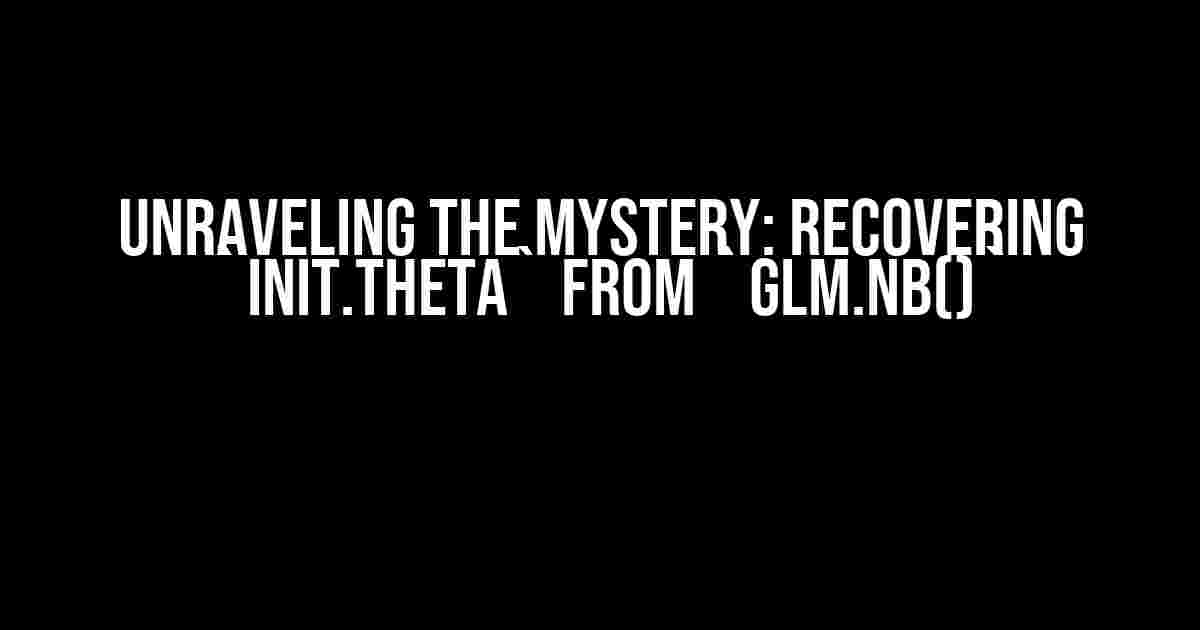Welcome to the fascinating world of regression analysis, where the veil of statistical uncertainty is lifted, and the underlying patterns of data are revealed. However, sometimes, even with the best of intentions, we find ourselves lost in the woods, struggling to recover a crucial parameter from the depths of the `glm.nb()` function. Fear not, dear reader, for today, we embark on a thrilling adventure to demystify the process of recovering `init.theta` from `glm.nb()`.
The Curious Case of `glm.nb()` and `init.theta`
In the realm of generalized linear models, `glm.nb()` is a powerful tool for modeling count data using negative binomial regression. The `init.theta` parameter, a fundamental component of the negative binomial distribution, is crucial for accurately estimating the dispersion parameter (theta) of the model. However, the `glm.nb()` function in R, by default, does not provide direct access to `init.theta`. This has left many a statistician scratching their heads, wondering how to recover this elusive parameter.
Why Bother with `init.theta`?
Before we dive into the nitty-gritty of recovering `init.theta`, it’s essential to understand why this parameter is so vital. The negative binomial distribution is a discrete probability distribution that models the number of failures until a specified number of successes is reached. In the context of regression analysis, `init.theta` is used to initialize the iterative process of estimating the dispersion parameter (theta). A well-chosen `init.theta` value can significantly impact the accuracy and convergence of the model. In essence, `init.theta` is the key to unlocking the full potential of the negative binomial regression model.
The Quest for `init.theta`
Now that we’ve established the importance of `init.theta`, it’s time to embark on the quest to recover this parameter. Fear not, dear reader, for the journey ahead is filled with twists and turns, but ultimately, it will lead us to the treasure trove of statistical knowledge.
Method 1: Using the `negbin` Package
One of the most straightforward methods to recover `init.theta` is by using the `negbin` package in R. This package provides an implementation of the negative binomial regression model, which includes an estimate of `init.theta`. To use this package, simply install and load it:
install.packages("negbin")
library(negbin)Next, fit the negative binomial regression model using the `negbin()` function:
fit_negbin <- negbin(y ~ x, data = mydata)The `init.theta` value can be accessed using the `getTheta()` function:
init_theta <- getTheta(fit_negbin)Voilà! You now have the recovered `init.theta` value.
Method 2: Using the `MASS` Package
Another approach to recover `init.theta` is by using the `MASS` package in R. This package provides an implementation of the negative binomial regression model, which can be used to estimate `init.theta`. To use this package, simply install and load it:
install.packages("MASS")
library(MASS)Fit the negative binomial regression model using the `glm.nb()` function:
fit_glmnb <- glm.nb(y ~ x, data = mydata)The `init.theta` value can be recovered by using the `theta.ml()` function:
init_theta <- theta.ml(fit_glmnb)And, once again, you have the recovered `init.theta` value.
Method 3: Using the `stats` Package
The third and final method to recover `init.theta` involves using the `stats` package in R. This package provides a range of statistical functions, including the `optim()` function, which can be used to estimate `init.theta`. To use this package, simply load it:
library(stats)Define a custom function to estimate `init.theta` using the negative binomial likelihood:
negbin_likelihood <- function(theta, y, x, mu) {
-sum(dnbinom(y, size = theta, mu = mu, log = TRUE))
}
mu <- exp(fit_glmnb$coefficients[1] + fit_glmnb$coefficients[2] * x)
init_theta <- optim(1, negbin_likelihood, y = y, x = x, mu = mu, method = "Brent")$parThe `init_theta` value is now recovered using the `optim()` function to minimize the negative binomial likelihood.
Conclusion
In conclusion, recovering `init.theta` from `glm.nb()` is a challenging task, but with the right tools and techniques, it can be achieved. We’ve explored three methods to recover `init.theta`, each with its own merits and limitations. Whether you choose to use the `negbin` package, the `MASS` package, or the `stats` package, the end result is the same: a recovered `init.theta` value that can be used to improve the accuracy of your negative binomial regression model.
Table of Contents
- The Curious Case of `glm.nb()` and `init.theta`
- Why Bother with `init.theta`?
- The Quest for `init.theta`
- Method 1: Using the `negbin` Package
- Method 2: Using the `MASS` Package
- Method 3: Using the `stats` Package
- Conclusion
By the end of this article, you should have a comprehensive understanding of how to recover `init.theta` from `glm.nb()`. Remember, in the world of statistics, knowledge is power, and the power to recover `init.theta` is now in your hands.
Frequently Asked Question
Get answers to the most pressing questions about recovering `init.theta` from `glm.nb()`!
Q1: What is `init.theta` in `glm.nb()` and why do I need to recover it?
`init.theta` is the initial value of the dispersion parameter `theta` in a negative binomial generalized linear model (GLM) fitted using `glm.nb()`. Recovering `init.theta` is essential because it’s used as a starting point for optimization, and a good initial value can significantly impact the model’s convergence and accuracy.
Q2: How do I recover `init.theta` from a fitted `glm.nb()` model in R?
You can recover `init.theta` by accessing the `theta` component of the fitted model object. For example, if your model is stored in the object `fit`, you can retrieve `init.theta` using `fit$theta`.
Q3: What if I want to specify a custom initial value for `theta` in `glm.nb()`?
You can pass a custom initial value for `theta` to `glm.nb()` using the `init.theta` argument. For example, `glm.nb(y ~ x, data, init.theta = 1.5)` would set the initial value of `theta` to 1.5.
Q4: Can I use the recovered `init.theta` value as a starting point for subsequent models?
Yes, you can use the recovered `init.theta` value as a starting point for subsequent models. This can be particularly useful when fitting multiple models with similar characteristics or when exploring different specifications.
Q5: Are there any scenarios where I wouldn’t need to recover `init.theta`?
If you’re only interested in the model’s coefficients and standard errors, you might not need to recover `init.theta`. However, if you’re working with complex models, exploring model diagnostics, or conducting sensitivity analyses, recovering `init.theta` can be essential.


